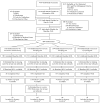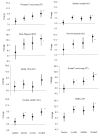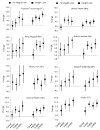Exercise dose and quality of life: a randomized controlled trial
- PMID: 19204218
- PMCID: PMC2745102
- DOI: 10.1001/archinternmed.2008.545
Exercise dose and quality of life: a randomized controlled trial
Abstract
Background: Improved quality of life (QOL) is a purported benefit of exercise, but few randomized controlled trials and no dose-response trials have been conducted to examine this assertion.
Methods: The effect of 50%, 100%, and 150% of the physical activity recommendation on QOL was examined in a 6-month randomized controlled trial. Participants were 430 sedentary postmenopausal women (body mass index range, 25.0-43.0 [calculated as weight in kilograms divided by height in meters squared]) with elevated systolic blood pressure randomized to a nonexercise control group (n = 92) or 1 of 3 exercise groups: exercise energy expenditure of 4 (n = 147), 8 (n = 96), or 12 (n = 95) kilocalories per kilogram of body weight per week. Eight aspects of physical and mental QOL were measured at baseline and month 6 with the use of the Medical Outcomes Study 36-Item Short Form Health Survey.
Results: Change in all mental and physical aspects of QOL, except bodily pain, was dose dependent (trend analyses were significant, and exercise dose was a significant predictor of QOL change; P < .05). Higher doses of exercise were associated with larger improvements in mental and physical aspects of QOL. Controlling for weight change did not attenuate the exercise-QOL association.
Conclusion: Exercise-induced QOL improvements were dose dependent and independent of weight change.
Trial registration: ClinicalTrials.gov NCT00011193.
Figures




Similar articles
-
Effects of different doses of physical activity on cardiorespiratory fitness among sedentary, overweight or obese postmenopausal women with elevated blood pressure: a randomized controlled trial.JAMA. 2007 May 16;297(19):2081-91. doi: 10.1001/jama.297.19.2081. JAMA. 2007. PMID: 17507344 Clinical Trial.
-
Dietary weight loss and exercise interventions effects on quality of life in overweight/obese postmenopausal women: a randomized controlled trial.Int J Behav Nutr Phys Act. 2011 Oct 25;8:118. doi: 10.1186/1479-5868-8-118. Int J Behav Nutr Phys Act. 2011. PMID: 22026966 Free PMC article. Clinical Trial.
-
Dose-Response Effects of Aerobic Exercise on Quality of Life in Postmenopausal Women: Results from the Breast Cancer and Exercise Trial in Alberta (BETA).Ann Behav Med. 2017 Jun;51(3):356-364. doi: 10.1007/s12160-016-9859-8. Ann Behav Med. 2017. PMID: 27837524 Clinical Trial.
-
Behavioral Counseling to Promote a Healthful Diet and Physical Activity for Cardiovascular Disease Prevention in Adults Without Known Cardiovascular Disease Risk Factors: Updated Systematic Review for the U.S. Preventive Services Task Force [Internet].Rockville (MD): Agency for Healthcare Research and Quality (US); 2017 Jul. Report No.: 15-05222-EF-1. Rockville (MD): Agency for Healthcare Research and Quality (US); 2017 Jul. Report No.: 15-05222-EF-1. PMID: 29364620 Free Books & Documents. Review.
-
Folic acid supplementation and malaria susceptibility and severity among people taking antifolate antimalarial drugs in endemic areas.Cochrane Database Syst Rev. 2022 Feb 1;2(2022):CD014217. doi: 10.1002/14651858.CD014217. Cochrane Database Syst Rev. 2022. PMID: 36321557 Free PMC article.
Cited by
-
Influence of habitual physical activity on the symptoms of climacterium/menopause and the quality of life of middle-aged women.Int J Womens Health. 2011;3:319-28. doi: 10.2147/IJWH.S24822. Epub 2011 Oct 4. Int J Womens Health. 2011. PMID: 22114524 Free PMC article.
-
Reduced peak oxygen uptake and implications for cardiovascular health and quality of life in patients with schizophrenia.BMC Psychiatry. 2011 Dec 5;11:188. doi: 10.1186/1471-244X-11-188. BMC Psychiatry. 2011. PMID: 22142419 Free PMC article.
-
Effects of 8-week Pilates exercise program on menopausal symptoms and lumbar strength and flexibility in postmenopausal women.J Exerc Rehabil. 2016 Jun 30;12(3):247-51. doi: 10.12965/jer.1632630.315. eCollection 2016 Jun. J Exerc Rehabil. 2016. PMID: 27419122 Free PMC article.
-
Effects of clinically significant weight loss with exercise training on insulin resistance and cardiometabolic adaptations.Obesity (Silver Spring). 2016 Apr;24(4):812-9. doi: 10.1002/oby.21404. Epub 2016 Mar 3. Obesity (Silver Spring). 2016. PMID: 26935138 Free PMC article. Clinical Trial.
-
Physical activity patterns in healthy middle-aged women.J Women Aging. 2016;28(6):469-476. doi: 10.1080/08952841.2015.1018067. Epub 2016 Jul 11. J Women Aging. 2016. PMID: 27399884 Free PMC article.
References
-
- Blair SN, Kohl HW, 3rd, Barlow CE, Paffenbarger RS, Jr, Gibbons LW, Macera CA. Changes in physical fitness and all-cause mortality. A prospective study of healthy and unhealthy men. JAMA. 1995;273:1093–1098. - PubMed
-
- Blair SN, Kohl HW, 3rd, Paffenbarger RS, Jr, Clark DG, Cooper KH, Gibbons LW. Physical fitness and all-cause mortality. A prospective study of healthy men and women. JAMA. 1989;262:2395–2401. - PubMed
-
- Gulati M, Pandey DK, Arnsdorf MF, et al. Exercise capacity and the risk of death in women: The St James Women Take Heart Project. Circulation. 2003;108:1554–1559. - PubMed
-
- Mora S, Redberg RF, Cui Y, et al. Ability of exercise testing to predict cardiovascular and all-cause death in asymptomatic women: A 20-year follow-up of the lipid research clinics prevalence study. JAMA. 2003;290:1600–1607. - PubMed
-
- Myers J, Prakash M, Froelicher V, Do D, Partington S, Atwood JE. Exercise capacity and mortality among men referred for exercise testing. N Engl J Med. 2002;346:793–801. - PubMed

